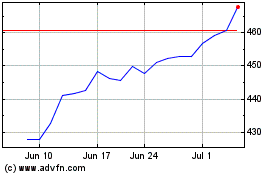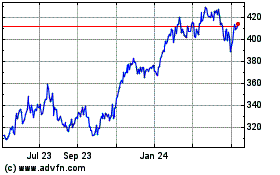Stock Market News for January 7, 2013 - Market News
January 07 2013 - 4:36AM
Zacks
The U.S economy kept up hiring at a
moderate pace in December, giving benchmarks a lift on Friday. The
S&P 500 closed at its highest level since 2007 following a
resolution to the Fiscal Cliff dilemma and a positive government
jobs report. Meanwhile, factory orders were stable in November
while the ISM Services Index climbed last month. The technology
sector was the only loser among the S&P 500 industry
groups.
The Dow Jones Industrial Average (DJI) gained 0.3% to close the day
at 13,435.21. The Standard & Poor 500 (S&P 500) surged 0.5%
to finish Friday’s trading session at 1,466.47. The tech-laden
Nasdaq Composite Index added 0.04% to end at 3,101.66.The
fear-gauge CBOE Volatility Index (VIX) plunged 5.0% to settle at
13.83. Consolidated volumes on the New York Stock Exchange,
American Stock Exchange and Nasdaq were roughly 6.07 billion
shares, lower than the daily average of 6.42 billion shares.
Advancing stocks easily outpaced decliners on the NYSE; as for 71%
stocks that rose, only 26% stocks moved lower.
Benchmarks finished the first week of the year on a high note. The
Dow Jones gained 3.8%, S&P 500 surged 4.6% and Nasdaq jumped
4.8% over the week. The blue-chip index recorded its best weekly
gains since June 2012. Stocks rallied during the previous week
after lawmakers managed to seal a deal on the Fiscal Cliff issue,
preventing the economy from sinking back into a recession. The
bullish sentiment in the markets dragged the VIX, the market’s fear
gauge lower for the fourth consecutive day. The VIX plunged nearly
40% in the previous week, logged its biggest ever weekly
decline.
The U.S. Bureau of Labor Statistics reported that total nonfarm
payroll employment surged by 155,000 in December, beating consensus
estimates of 144,000. The increase in nonfarm payroll employment
was due to gains by health care, food services and drinking places,
construction, and manufacturing. Health care added 45,000 more
jobs, whereas food services and drinking places accounted for
38,000 new jobs. Employment in construction and manufacturing also
increased 30,000 and 25,000 respectively. The unemployment rate
came in flat at 7.8% in December. This was below consensus
estimates of 7.7%.
Additionally, the U.S department of commerce reported factory
orders in November were unchanged from the previous month. This was
contrary to consensus estimates of an increase of 0.4% in November.
According to the report, new orders surged $0.2 billion to $477.6
billion. Shipments gained 0.4% to $483.7 billion, whereas unfilled
orders added 0.1% to $984.5 billion. Orders for inventories
declined marginally to $615.2 billion.
The Institute of Supply Management said the non-manufacturing
sector expanded in December. According to the report, the ISM
Services Index increased to 56.1 in December from 54.7 in November.
This was above consensus estimates of 54.5. New orders gained 1.2%
to 59.3 whereas the employment index gained 6.0% to 56.3. However,
the business index declined 0.9% to 60.3.
Technology bellwether Apple Inc. (NASDAQ:AAPL) lost 2.8% and was
largely responsible for dragging the sector lower on Friday. Apple
had lost almost 25% since touching an all time high in September.
The Technology SPDR (XLK) lost 0.5%. Stocks such as Microsoft
Corporation (NASDAQ:MSFT), International Business Machines Corp.
(NYSE:IBM), Intel Corporation (NASDAQ:INTC) and Texas Instruments
Incorporated (NASDAQ:TXN) slipped 1.9%, 0.7%, 0.8% and 0.2%,
respectively.
APPLE INC (AAPL): Free Stock Analysis Report
INTL BUS MACH (IBM): Free Stock Analysis Report
INTEL CORP (INTC): Free Stock Analysis Report
MICROSOFT CORP (MSFT): Free Stock Analysis Report
TEXAS INSTRS (TXN): Free Stock Analysis Report
To read this article on Zacks.com click here.
Zacks Investment Research
Microsoft (NASDAQ:MSFT)
Historical Stock Chart
From Mar 2024 to Apr 2024

Microsoft (NASDAQ:MSFT)
Historical Stock Chart
From Apr 2023 to Apr 2024
